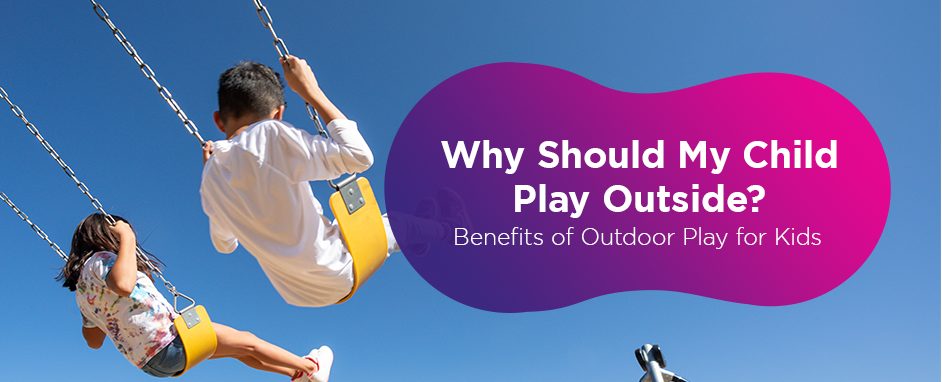Swings are good for kids because they provide physical exercise and promote sensory development. Swings allow kids to swing back and forth, which helps improve their balance, coordination, and muscle strength.
Additionally, the swinging motion stimulates their senses, including their vestibular system, which is responsible for balance and spatial orientation. This sensory stimulation can enhance their overall sensory integration skills and contribute to their cognitive and emotional development. Overall, swings offer a fun and beneficial activity for kids that can support their physical and sensory well-being.


Credit: www.miracle-recreation.com
1. Physical Benefits
Swings are beneficial for kids as they improve balance and coordination, strengthen core muscles, enhance motor skills, and stimulate sensory integration. By using swings, children engage in a rhythmic motion that challenges their control and stability. This helps them develop a better sense of balance and coordination, which is crucial for their overall physical development.
Swinging also targets the core muscles, including the abdominals and back muscles, as they work to maintain stability. This not only helps improve posture but also builds strength in these important muscle groups. Additionally, swinging encourages the development of motor skills by requiring children to use their arms and legs to propel themselves forward and backward.
It also fosters spatial awareness as they learn to navigate the swinging motion in relation to their surroundings. Lastly, swinging stimulates sensory integration as the repetitive movement and sensation of swinging can have a calming and regulating effect on children’s nervous systems.
2. Psychological Benefits
Swings offer a variety of psychological benefits for children. They have the power to boost mood and overall happiness, helping kids find joy and excitement. By swinging back and forth, children can release stress and anxiety, feeling a sense of calm and relaxation.
Swings also stimulate and encourage creativity and imagination, allowing kids to explore their minds and come up with new ideas. In addition, swinging on a swing set can foster social interaction and communication skills, as children play together and take turns using the swing.
This helps kids build friendships, develop empathy, and learn how to effectively communicate with others. Overall, swings provide a fun and therapeutic experience for children, promoting their emotional well-being and enhancing their overall development.
3. Cognitive Benefits
Swings offer numerous cognitive benefits for kids. They enhance cognitive development, improve concentration, and promote focus. By engaging in swinging, children develop problem-solving and critical thinking skills. Swinging also stimulates brain development and enhances learning abilities in children. The rhythmic motion and sensory experiences provided by swinging activate various regions of the brain, allowing for improved cognitive function.
It encourages the brain to make connections and strengthens neural pathways, facilitating learning and memory retention. Moreover, swinging helps children to effectively process information and make sense of their surroundings. The combination of physical movement and cognitive stimulation makes swings an excellent tool for supporting children’s cognitive growth and overall development.
Frequently Asked Questions Of Why Are Swings Good For Kids?
Why Should Kids Play On Swings?
Playing on swings helps kids develop important motor skills, balance, coordination, and strength. It also encourages social interaction, promotes imaginative play, and enhances their overall physical and mental well-being.
What Are The Benefits Of Swinging For Kids?
Swinging helps improve sensory integration, which is crucial for a child’s neurological development. It stimulates the vestibular system, promotes a sense of rhythm, enhances concentration, and reduces stress and anxiety. It’s a fun way for kids to engage in active play and enjoy the outdoors.
How Does Swinging Benefit A Child’S Physical Health?
Swinging provides a low-impact workout that strengthens the core muscles, legs, and arms. It helps improve posture, flexibility, and cardiovascular endurance. The rhythmic motion of swinging also stimulates the inner ear, aiding in balance and spatial awareness development.
Can Swinging Help With A Child’S Cognitive Development?
Yes, swinging can have a positive impact on a child’s cognitive development. The back-and-forth motion enhances focus, concentration, and attention span. It also stimulates the brain’s proprioceptive input, contributing to sensory integration and helping with spatial awareness and problem-solving skills.
Conclusion
Swings provide numerous benefits for children’s physical, mental, and emotional development. From promoting balance and coordination to enhancing sensory integration and providing an outlet for imaginative play, swings offer a wide range of advantages. Additionally, the repetitive motion of swinging can have a calming effect on children, reducing anxiety and stress.
Swinging also fosters social interaction and cooperation when children take turns and engage in shared play experiences. Whether it’s the exhilarating feeling of soaring through the air or the simple joy of swinging back and forth, it’s clear that swings hold a special place in children’s hearts.
As parents and caregivers, we can support children’s well-being by prioritizing outdoor playtime and ensuring access to swings as part of their play experiences. So, embrace the magic of swings and watch your kids thrive and grow with every push and giggle!




Pingback: How to Swing on a Swing: Follow These Proven Techniques